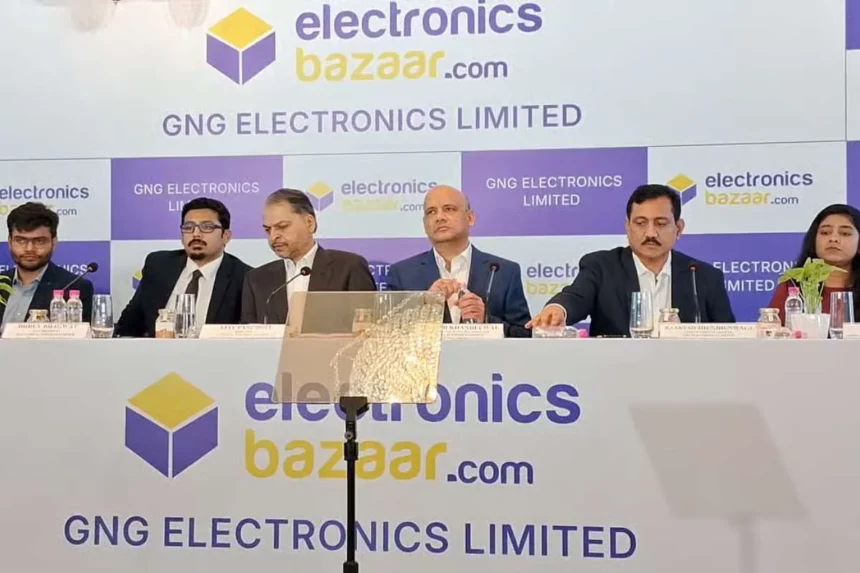NEW DELHI – GNG Electronics Limited, known as a major player in India’s market for refurbished laptops and desktops, closed its initial public offering (IPO) with remarkable demand. The GNG Electronics IPO saw a subscription rate of 150.21 times, drawing attention from all investor groups: retail, non-institutional, and qualified institutional buyers.
The success of the GNG Electronics IPO has set a benchmark for future listings in the sector.
After a three-day bidding window ending on 25 July 2025, the allotment wrapped up by 28 July, with shares ready to trade on both the BSE and NSE from 30 July. Market watchers are following the grey market premium (GMP) and allotment results closely, hoping for healthy listing gains.
GNG Electronics IPO Enormous Subscription Figures
The GNG Electronics IPO was valued at ₹460.43 crore, including a fresh share issue worth ₹400 crore and an offer for sale totalling ₹60.44 crore. Shares were priced between ₹225 and ₹237 each. The IPO attracted bids for over 208.39 crore shares, dwarfing the 1.41 crore available.
The response from institutional investors was especially strong, with the QIB segment subscribed 266.21 times. Non-institutional investors followed at 226.44 times, while retail investors subscribed 47.36 times. This high demand has made the share allotment tough, especially for retail investors, where only about one in 36 applicants is expected to get the minimum lot of 63 shares, costing ₹14,931.
GNG Electronics, founded in 2006 and operating under the Electronics Bazaar brand, has built a solid reputation in the refurbishment of information and communication technology (ICT) devices. Its reach extends across 38 countries, including India, the USA, Europe, Africa, and the UAE.
The company meets growing demand for quality refurbished electronics and works with top brands like HP, Lenovo, and Microsoft. It holds quality and recycling certifications that support its strong track record.
Grey Market Premium Reflects Investor Optimism
GNG Electronics has generated buzz with a solid GMP. As of 28 July 2025, the GMP registered at ₹94, down from a peak of ₹105 earlier in the bidding period. This points to a possible listing price near ₹331 per share, which is almost 40% above the IPO’s top price of ₹237. The GMP has moved between ₹71 and ₹105 in recent sessions but remains high, showing investors expect good opening returns. However, GMP figures are unofficial and can shift with market moods.
Market analysts say GNG’s strong GMP reflects its solid financials and a positive industry outlook. In FY25, GNG Electronics reported revenue of ₹1,411 crore, compared to ₹659.54 crore in FY23.
Profit after tax stood at ₹69 crore, with a return on equity above 35%. The company’s growth is backed by a 46% compound annual rate in both revenue and profit between FY23 and FY25. GNG stands out in a global market for refurbished electronics that is predicted to reach $352.4 billion by 2029, growing at more than 10% per year.
Share Allotment and How to Check Results
The GNG Electronics IPO allotment wrapped up on 28 July 2025. Shares will be credited to investors’ demat accounts, and refunds will go out to those who did not secure shares by 29 July.
Due to heavy oversubscription for the GNG Electronics IPO, retail allotment was decided by random draw. Investors can check their allotment status on the BSE website, NSE portal, or through the registrar, Bigshare Services Pvt Ltd. To check, investors need to select “GNG Electronics Limited” and enter their PAN, application or demat account details.
Applicants who used their broker or bank’s ASBA facility can also check the status via their trading or bank portal under IPO history. The strong showing from investors has meant slim allotment chances for most. High-net-worth individuals faced tough odds, too, with allocation ratios estimated at 1 in 174 for small HNIs and 1 in 54 for large HNIs.
How GNG Plans to Use the Funds
GNG Electronics intends to spend ₹400 crore from the fresh share issue largely on reducing debt. Around ₹320 crore will go to repaying or prepaying loans at GNG and its subsidiary Electronics Bazaar FZC. The rest will be used for general purposes such as expansion and marketing. By paying down debt, GNG aims to raise profits through lower interest costs and support steady business growth.
The company has carved out a strong position in India’s refurbished ICT sector, while its international links and focus on sustainable practices match national goals like “Make in India.” Still, challenges such as overdependence on a small group of clients, inventory issues, and intense competition in electronics might affect profit margins. Investors should review the Red Herring Prospectus for more details.
Expert Views and Outlook
Most analysts remain positive about GNG Electronics’ future, often rating the IPO as a “subscribe” for those willing to stay invested for the medium or long term. Prashanth Tapse of Mehta Equities expects listing gains of 25% or more, suggesting cautious investors might choose to book profits on debut.
He also points to GNG’s ability to scale and meet environmental, social, and governance (ESG) criteria for those willing to take more risk. Gaurav Goel of Fynocrat Technologies praises the company’s position in a high-growth market, though he thinks the IPO is fully priced.
As GNG Electronics’ IPO is set to debut on 30 July 2025, the combination of strong business results, healthy GMP, and eager investor response makes it attractive. Still, tough allotment odds and market swings mean investors should keep a close watch on its first trading day and set stop-loss orders. For those who get an allotment, GNG offers an entry into India’s fast-growing refurbished electronics sector, as long as they remain mindful of market risks.
Disclaimer: This GNG Electronics IPO summary is based on market reports and analyst comments. Investors should consult their financial adviser before making decisions.














